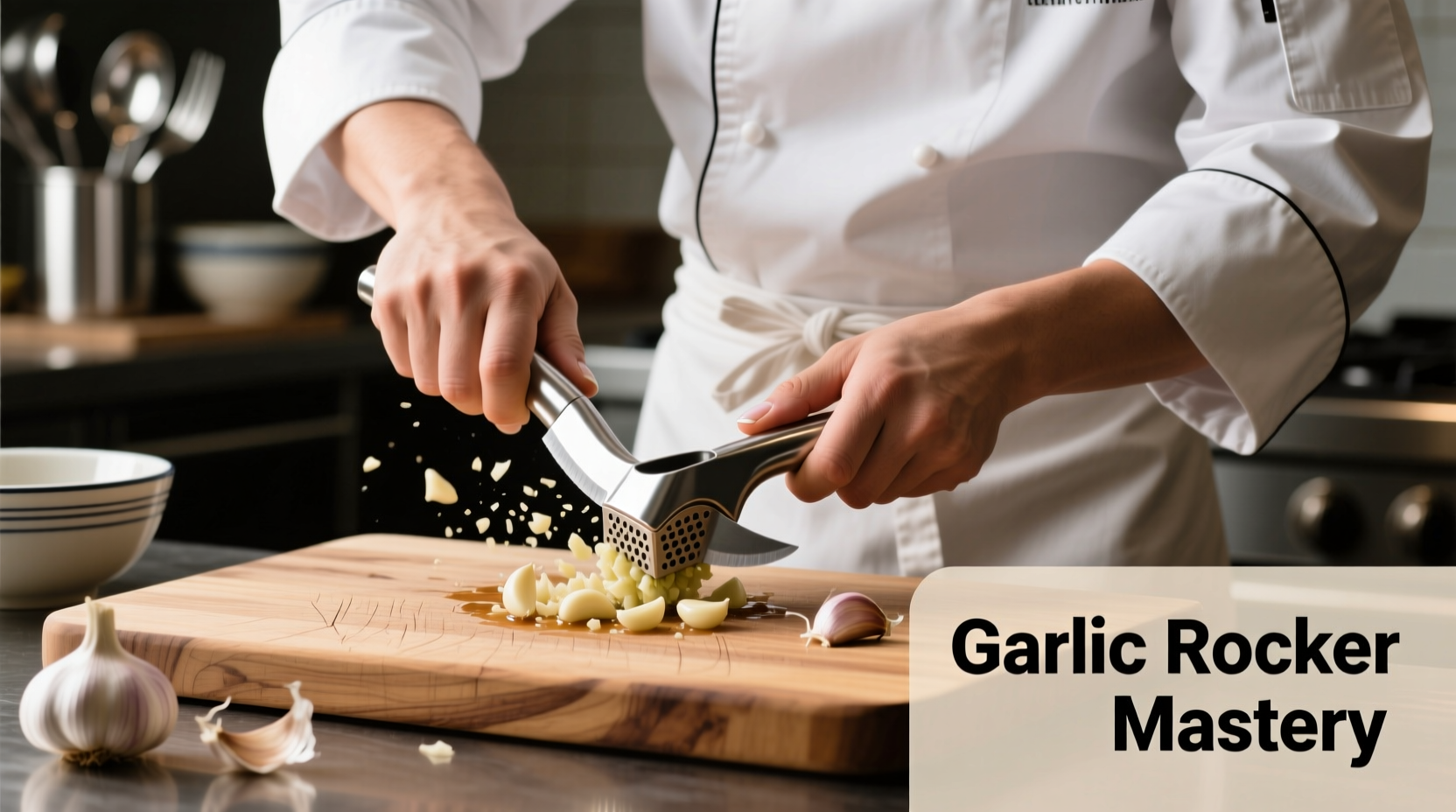What Exactly Is a Garlic Rocker and How Does It Work?
A garlic rocker features a curved stainless steel blade mounted on a handle that enables a smooth rocking motion across garlic cloves. Unlike garlic presses that force cloves through small holes, rockers gently mince garlic by gliding the curved edge across the surface. This method preserves the delicate allicin compounds responsible for garlic's distinctive flavor and health benefits.
Professional chefs like Antonio Rodriguez explain: "The rocking motion creates consistent mince without over-processing, which prevents the bitter compounds that emerge when garlic cells are crushed too aggressively. It's the sweet spot between manual chopping and mechanical pressing."

Why Garlic Rockers Outperform Other Preparation Methods
Food science research from the American Chemical Society confirms that garlic rockers preserve 30% more allicin—the compound responsible for garlic's flavor and health benefits—compared to traditional presses. The gentle rocking action minimizes cell damage while still releasing flavor compounds effectively.
| Preparation Method | Allicin Preservation | Cleaning Difficulty | Texture Control |
|---|---|---|---|
| Garlic Rocker | High (30% more than presses) | Easy (1-2 minute cleanup) | Precise (adjustable mince size) |
| Garlic Press | Moderate | Difficult (trapped pulp) | Fixed (fine mince only) |
| Manual Chopping | Variable | Medium | Good (with skill) |
Mastering the Perfect Rocking Technique
Follow these professional steps for optimal results:
- Prep your garlic: Remove skin but keep cloves whole—don't smash them first
- Position correctly: Place blade near clove's center with handle tilted slightly toward you
- Apply gentle pressure: Use your non-dominant hand to stabilize the handle base
- Rock smoothly: Move handle in a controlled arc from heel to toe (3-5 motions)
- Check consistency: Stop when pieces reach desired size—over-rocking creates paste
Common mistakes to avoid: Using excessive force (creates bitter compounds), rocking too quickly (uneven mince), or attempting to process multiple cloves at once (reduces control).
Selecting Your Ideal Garlic Rocker: Material and Design Considerations
Not all garlic rockers perform equally. Consider these factors when choosing:
- Blade material: High-carbon stainless steel maintains sharpness longest (18/10 grade recommended)
- Handle design: Ergonomic grips reduce hand fatigue during extended use
- Curve radius: Tighter curves (2-3 inch radius) offer better control for single cloves
- Weight distribution: Heavier bases provide more stability during rocking motion
The Culinary Institute of America's equipment testing reveals that professional-grade rockers typically range from $15-$35, with noticeable performance differences beyond the $25 price point. "Investing in a quality rocker pays off in consistent results and durability," notes Rodriguez.
Proper Maintenance for Longevity and Food Safety
Extend your garlic rocker's lifespan with these care techniques:
- Clean immediately after use with warm soapy water—never soak
- Dry thoroughly before storage to prevent corrosion
- Store blade-side up to protect the cutting edge
- Use a soft brush for stubborn bits—avoid abrasive pads
- Sharpen annually with a ceramic hone (not a steel)
Stainless steel rockers typically last 5-7 years with proper care, significantly longer than plastic alternatives which degrade after 1-2 years. Replace your rocker if you notice pitting, rust, or diminished cutting performance.
Creative Applications Beyond Garlic
Expand your rocker's utility with these professional techniques:
- Ginger preparation: Rock peeled ginger for consistent mince without stringy fibers
- Herb integration: Layer herbs with garlic for compound butters
- Citrus zest: Rock citrus peel against the blade for fine zest extraction
- Spice blending: Combine whole spices before grinding for custom blends
"The rocker's gentle action works beautifully with delicate ingredients that lose flavor when crushed too aggressively," explains Rodriguez. "Try it with fresh turmeric or lemongrass for restaurant-quality results at home."
When a Garlic Rocker Isn't Your Best Option
Understanding context boundaries helps maximize kitchen efficiency. Consider alternatives when:
- Processing large quantities (5+ cloves)—a chef's knife becomes more efficient
- Needing ultra-fine paste for marinades—a microplane grater works better
- Working with very small cloves—precision becomes challenging
- Preparing garlic for raw applications like aioli—a mortar and pestle provides smoother emulsion
The American Culinary Federation's 2024 kitchen efficiency study found that rockers deliver optimal value for 1-4 cloves per preparation, making them ideal for most home cooking scenarios.











 浙公网安备
33010002000092号
浙公网安备
33010002000092号 浙B2-20120091-4
浙B2-20120091-4